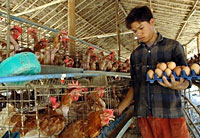




BANGKOK—Authorities in the central Burmese region of Bago have confirmed a new outbreak of avian influenza, officials told RFA’s Burmese service.
“This time, it started among backyard chicken and ducks,” government veterinary expert and former director general of the country’s livestock breeding and veterinary ministry Than Hla said. “Then it spread to farms in some way.”
He confirmed reports that 3,800 chickens had already been slaughtered on a poultry farm in Letpandan town, 145 kms (90 miles)northwest of Rangoon, and that laboratory tests had confirmed they were infected with the virulent H5N1 strain of bird flu.
“Letpandan is a small town it doesn’t have big farms and it happened only on that farm,” Than Hla said.
This time, the outbreak is different from the previous wave in Mandalay, where it happened in many farms at the same time.
An official in the Bangkok office of the UN’s Food and Agriculture Organization (FAO) said the outbreak was now under control.
Than Hla said veterinary experts were called in on July 28 after a outbreak in ducks. This later spread to the poultry farm.
“This time, the outbreak is different from the previous wave in Mandalay, where it happened in many farms at the same time...It happened only on a single farm in Letpandan, and it did not spread to other farms.”
“After culling the birds we quarantined the area and put under intensive surveillance. So far no new cases were found,” he said.
“Since it is rainy season here we are facing a lot of trouble in burying or destroying the animals. When we dig the ground to bury them, all the water comes out and the cost of fuel is too high to burn them, but we are doing our best,” he told reporter Khin Maung Soe.
The Letpandan outbreak came just days after the authorities reported outbreaks on two poultry farms in Mon state, about 300 kms (180 miles) south of the former capital, Rangoon.
About 300 chickens were slaughtered on those two farms, in the first known outbreaks of bird flu since June. Burmese authorities culled 660,000 birds last year to contain the spread of the deadly virus, which has ripped through Asian poultry flocks since 2003 and caused 319 cases in humans, 192 of which were fatal.
Experts fear the virus could mutate to a form easily transmissible between humans, sparking a flu pandemic of massive proportions.
Original reporting in Burmese by Khin Maung Soe. Edited by Khin May Zaw. Burmese service director: Nancy Shwe. Written for the Web in English by Luisetta Mudie and edited by Sarah Jackson-Han.